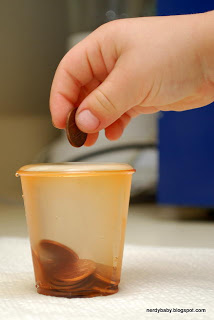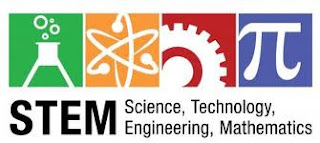Full STEAM Ahead Camp
Thursday, August 15, 2013
Wednesday, August 14, 2013
Rachelle the scientist is ready to hit the lab!
A battery made up of coins...http://www.sciencebuddies.org/science-fair-projects/project_ideas/Energy_p015.shtml#summary
Making mixtures and seeing which substances dissolve...http://www.sciencebuddies.org/science-fair-projects/project_ideas/MatlSci_p014.shtml#materials
How salty is the water (the only downfall is that we would need a lot of water from various places)...http://www.sciencebuddies.org/science-fair-projects/project_ideas/OceanSci_p009.shtml#procedure
Another experiment with dissolving is seeing which liquid dissolves the sweet tarts the quickest...http://mesmrswhitesclass.blogspot.com/2013/03/week-25-sweet-tart-chemistry-geometry.html
Rachelle the scientist is ready to hit the lab!
A battery made up of coins...http://www.sciencebuddies.org/science-fair-projects/project_ideas/Energy_p015.shtml#summary
Making mixtures and seeing which substances dissolve...http://www.sciencebuddies.org/science-fair-projects/project_ideas/MatlSci_p014.shtml#materials
How salty is the water (the only downfall is that we would need a lot of water from various places)...http://www.sciencebuddies.org/science-fair-projects/project_ideas/OceanSci_p009.shtml#procedure
Another experiment with dissolving is seeing which liquid dissolves the sweet tarts the quickest...http://mesmrswhitesclass.blogspot.com/2013/03/week-25-sweet-tart-chemistry-geometry.html
Art and Food!--Scott knows what kids love!
Patterns with fuse beads. Students develop a pattern based design using fuse beads.
- Materials: Fuse beads, iron, wax paper
- Can be connected to art and math standards as well as fine motor skills for our primary kids.
Spaghetti and Marshmallow Towers
- Materials: Spaghetti, mini marshmallows
- Students build a tower using spaghetti and marshmallows. Grouping is flexible or can be done individually. We can simplify it so that the primary kids just build however they like. Upper grades can be given additional criteria for their buildings and material limitations/budgets.
Great Ideas Taylor!!!
http://pbskids.org/designsquad/parentseducators/resources/pop_fly.html
http://pbskids.org/designsquad/parentseducators/resources/rubber_band_car.html
http://www.sciencekids.co.nz/gamesactivities/circuitsconductors.html (2 wires, battery and light bulb-have students work to light the bulb with those materials)
Sun is full of great ideas!
Activity l: Egg/balloon in a bottle (glass bottles, strips of paper, matches, small water balloons)
Activity2: M&M survival challengehttp://www.sciencebuddies.org/science-fair-projects/project_ideas/Zoo_p012.shtml#procedure
Activity 3: build and test paper planes with different drags http://www.sciencebuddies.org/science-fair-projects/project_ideas/Aero_p046.shtml#procedure
Activity 4: Bouncy polymer chemistry(make putty)
Activity 5: Scale Factor Project( for 5th and 6th grade)
Pick a 3D object and make it bigger or smaller: incorporates art and math, pair work, takes 2-3 days, low material cost
Christine had a major brainstorm!
Design a new a toy. Write a proposal and then draw a schematic. If time, create a prototype.
Create rhythm instruments and then compose and play rhythm music.
Design and make a scale model of multi-use city park. Consider the needs of children,teens, athletes, seniors, and families. Create a 3d model.
Using natural plant materials, create paints and and then use them to paint a picture.
Tuesday, August 13, 2013
Kristen clearly has STEM on her mind!
These are all geared towards 3rd-6th grade:
This website had a tone of GREAT STEM ideas :)
This STEM activity has students working collaboratively with a group to design a model of an aqueduct that would be able to transport water from point A to point B.
http://thirdgradethinkers8.blogspot.com/2013/01/implementing-stem-activities-worth.html
In this activity, students learn about the engineering design process and the physical principles of buoyancy by working together to build a boat out of straws and plastic wrap that can hold 25 pennies for at least 10 seconds before sinking.
Marshmallow Design Challenge
Balloon Powered Car
Funny Putty
What do you know about BUOYANCY?--Alyssa can help you find out more!
|
Steam
Camp
|
||||||||||||||||||||
|
NGSS Student Outcome
|
||||||||||||||||||||
|
Topic
Buoyancy
|
||||||||||||||||||||
|
Flipp class-
How did the buoyancy expert get the boat to sink?
Why did the air pocket increase as the buoyancy expert went
deeper into the water?
This site will extend concept of buoyancy
Jackie has COLORFULLY fun ideas!
http://tlc.howstuffworks.com/family/science-projects-for-kids-spectrum-of-colors.htm

What's happening:
When water seeps up the filter paper, it separates the different colors so you can see them. M&M brown works especially well--the different dyes separate out into a rainbow.
You can try this experiment with anything that contains dye, including juice, markers, or ballpoint pen (that’s why it’s better to mark your labels with pencil).
Explanation based on author's interview with Walter Bowyer, chemistry professor at Hobart and William Smith Colleges
Make a Kaleidoscope with your kids that reflects the spectrum of colors.
©2007 Publications International, Ltd.
©2007 Publications International, Ltd.
Science projects for kids: spectrum of colors are interactive learning experiences that leave a lasting impression. Teach kids valuable lessons about color, light, and science with projects about the spectrum of colors.
Bring out colors using light, chemicals, and natural objects. Use science projects to create a sense of wonder in kids, as well as a deeper understanding of the natural world.
On the following pages, you will learn science projects that teach kids important lessons about the spectrum of colors.
Teach kids how to create the full spectrum of colors with black and white paper. Read about Not Just Black and White, a science project for kids.
Which colors are most visible at a distance? Find out when you learn about Colors at a Distance, a science project for kids.
A Kaleidoscope uses mirrors to reflect the spectrum of colors and create complex images. Find out how to make a Kaleidoscope.
Teach kids a science project that reveals what colors leaves will turn in the fall. Learn about Discover Hidden Leaf Colors, a science project for kids.
Find out how to use antacid tablets to create vibrant colors in this science project for kids. Read about Racing Color Changes.
This dramatic science project for kids uses chemicals to create vibrant color shifts. Learn about Erupting Weird Color Flow.
Not Just Black and White is a science project that teaches kids how to create vibrant colors using only black and white. Learn this science project on the next page of science projects for kids: spectrum of colors.
http://www.candyexperiments.com/2010/09/color-separation-chromatography.html
Color Separation (Chromatography)
Please do not copy, sell, post, publish, or distribute all or any part of this material without the author's permission. Instead, feel free to link to this website, and to contact me with questions.
You know candy is colored with artificial dye. But did you know that many candies contain several kinds of dye? To see the different dyes for yourself, try this.
You know candy is colored with artificial dye. But did you know that many candies contain several kinds of dye? To see the different dyes for yourself, try this.
What you need:
- A rectangle of coffee filter paper
- Dyed candy such as M&Ms, Skittles, or Reese's Pieces
- A glass filled with a half-inch of water
- A pencil
What to do:
- Place drops of water on a flat surface, such as a plate, a cookie sheet, or tinfoil.
- Place candy on water and let color dissolve.
- Crease the coffee filter paper vertically (to help it stand up).
- Dab or paint a drop of candy-colored water onto the paper, an inch from the bottom. If you're testing several colors, label each with pencil.
- Stand the paper up in the glass of water, with the water level below the color splotch. (If the paper doesn't stand, check here for tips on folding or clipping the paper in place.)
- Watch the water seep up to the top edge of the paper.
What's happening:
You can try this experiment with anything that contains dye, including juice, markers, or ballpoint pen (that’s why it’s better to mark your labels with pencil).
Explanation based on author's interview with Walter Bowyer, chemistry professor at Hobart and William Smith Colleges
 Guide to Light and Color
Guide to Light and Color
Do you have a favorite color? Most people do, however for many people, it changes from time to time. Look around you. What colors do you see? What makes it possible for our eyes to see light and enjoy different colors? It's a sure thing that color adds beauty to anything it touches in our world. Scientists have done studies that show certain colors will stimulate the brain in different ways. It's funny to think that different colors are calming while others are energizing. Color and light are necessary elements in our world and make huge visual differences in our lives.
When trying to understand light and color, we must first understand that light travels in the form of a wave. These waves consist of both high and low points. The amount of distance between these points is called a wavelength. Short wave lengths will have a high amount of energy. Long wave lengths will have a low amount of energy. A good example of colorful wavelengths is the rainbow. The sun gives off its radiation which our eyes construe as the colors we see. There are seven colors in the rainbow and include red, orange, yellow, green, blue, indigo and violet. This is known as the visible spectrum.
|
Monday, August 12, 2013
The Kids Will Surely Bounce off the Walls With These!--Sandi
HOMEMADE BOUNCY BALLS!
(NO KIDDING! Just like out of the gumball machine! great to do with the kids...or FOR the kids!)
2 cups
Measuring spoons
A stir stick
2 tbsp hot water
1/2 tsp borax
1 tbsp glue
1 tbsp corn starch
Food coloring (optional)
Pour the water and borax into the first cup and stir the mixture until it is dissolved.
Pour the glue, cornstarch and food coloring into the second cup and mix. Then add the mixture from the first cup into the second cup.
Let the ingredients sit for 15 seconds then stir.
Once the mixture becomes difficult to stir, scoop it out of the cup, and roll into a ball. Enjoy!!!
Geometry and Art--A Great Pair!--Thanks Priscilla!
These activities could be utilized for a variety of grade levels and work time
This website posts a variety of patterned, non-representational art, which they call "tangles", I think it could be used to fill in designs for geometrical shapes and a variety of designs related to math...
<http://tanglepatterns.com/organize-your-patterns>
<http://tanglepatterns.com/organize-your-patterns>
Students could create their own personal logos. Businessmen and businesswomen in the making at AEA!
Bubbles, Balloons, and Bridges with Brittney!
Balloon
Blast off
Materials-
Balloons
Tape
String
Straws
Procedure-
Try to have the balloon hit a target across the room using
these materials.
Balls and
Ramp
Materials-
Balls and Ramp
Marbles
Paper towel roll
Construction paper
Tape
Stairs
Procedure
- Try to make a clock that measures
exactly 10 seconds.
- The only materials you can use are
marbles, paper towel rolls, construction paper, tape, and a flight of
stairs.
If
the marble gets to the bottom of the stairs in exactly 10 seconds, without any
help from you, you've mastered our challenge!
Bubble City
Materials-
Bubble
solution
Straws or
wire
Procedure-
Think of
ways to make the soap bubbles square using the straws or wire.
Straw Bridge
Materials-
Straws
Paper clips
Something to
test strength
Procedure-
Build the craziest designed bridge using only straws and paper clips
that can span 30 centimeters and support the most weight. You first have to
think of a plan of how you are going to build your structure.
Subscribe to:
Comments (Atom)














